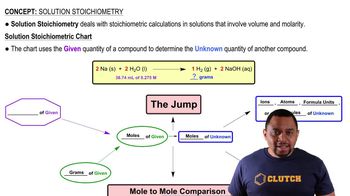Here are the essential concepts you must grasp in order to answer the question correctly.
Molarity
Molarity is a measure of concentration defined as the number of moles of solute per liter of solution. It is expressed in units of moles per liter (M). Understanding molarity is essential for calculating the concentration of ions in a solution, as it directly relates to the amount of solute dissolved in a given volume of solvent.
Recommended video:
Dissociation of Ionic Compounds
Ionic compounds, such as sodium chloride (NaCl), dissociate into their constituent ions when dissolved in water. In the case of NaCl, it separates into Na<sup>+</sup> and Cl<sup>-</sup> ions. This dissociation is crucial for determining the concentration of specific ions, like Cl<sup>-</sup>, in a solution based on the initial concentration of the ionic compound.
Recommended video:
Stoichiometry of Solutions
Stoichiometry involves the quantitative relationship between reactants and products in a chemical reaction. In the context of solutions, it helps in calculating the amounts of ions produced from a given concentration of an ionic compound. For example, knowing that one mole of NaCl produces one mole of Cl<sup>-</sup> allows for straightforward calculations of ion concentration from the molarity of the salt solution.
Recommended video:

 Verified step by step guidance
Verified step by step guidance


